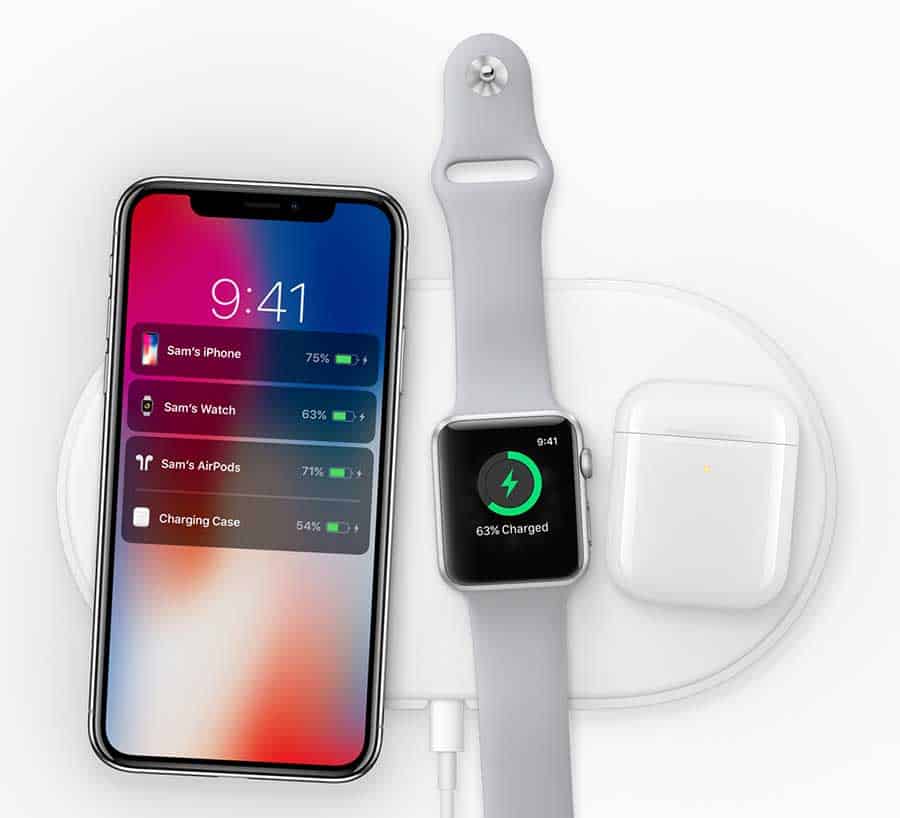
Above: All of Apple’s new devices support wireless charging, seen here on a Belkin charging base. Earpod users will need to get the special wireless charging case. Photo courtesy Apple.
BitDepth#1111 for September 19, 2017
Apple spent a lot of time introducing a rather slim slate of new products at last week’s launch of new iPhones.
The company introduced software level updates to its AppleTV streaming media product, a new Apple Watch and three new iPhone devices.
New CEO Tim Cook also took a lot of time out of the event to pay homage to his predecessor, the late Steve Jobs.
Some of it was appropriate, since the event christened the admittedly astonishing Steve Jobs Theater, the first building opened to the public on the new Apple Campus.
It wouldn’t have made sense for Cook to ignore the iconic leader who brought Apple not just back from a business coma, but actually managed to change the world of communications with the first iPhone.
Cutting right past the honorifics and stage sleight of hand, these are the critical revelations that customers will really want to know.
Cook announced that the Apple Watch is now the number one watch in the world, boasting 50 per cent annual growth.
The device deepened its emphasis on health and fitness tracking and is absolutely bang on with its new features for heart rate tracking and data analysis.
Not only will the watch look for troubling patterns in your heartbeat, the aggregated data of Apple Watch users will become part of the Apple Heart Study, an effort to analyse heart conditions being established in partnership with Stanford Medicine.
If you’re young enough not to be concerned about arrythmia, then the new eSim chip in the device, which acts as a multiplier for the one in your phone, should catch your eye. We’re now officially in Dick Tracy territory with this version of the wearable, since you can receive and answer calls on your wrist.
Athletes will be keen on the device’s ability to stream up to 40 million songs from Apple Music to the company’s Bluetooth headphones without a phone in sight.
The new eSim cellular technology requires cooperation with carriers and no Caribbean country, including T&T, is on the list yet.
The new AppleTV adds 4K resolution to its HD offerings. If you’ve bought HD content in the past, it will be upgraded at no cost.
There’s a new iPhone 8 and 8 Plus, but let’s start with the new iPhone X, which won’t be available until November, alas.
As the new flagship of the iPhone line, every good new thing is baked into this device right from the start. The iPhone 8 and 8 Plus don’t get the new screen and keep their home buttons.

The new iPhoneX features a diminished bezel and frame and eliminates the home key. Photo courtesy Apple.
What’s unique for iPhoneX users is a display that runs right to the edge of the device and a glass backing that’s held together with a band of surgical grade stainless steel that’s gorgeous to behold.
The iPhoneX sports a new “Super Retina” OLED display that packs 458 pixels into every square inch of screen real estate.
To create a full screen display, Apple has ditched the home button in favour of a swipe up of the thumb.
The new phone ships with a new processor, the A11 Bionic chip that Geekbench clocks with numbers that have more in common with a Macbook than a smartphone.
It gets the “bionic” title not from any attempt at linking the new phone to Steve Austin adventurings but from a new chipset included in the processor that’s dedicated to running the neural engine and learning algorithms that power the new iPhone security layer, Face ID.
Apple packs a range of sensors into the cutout in the display at the top of the phone that manage the face mapping and detail acquisition that will deliver, the company claims, a one in a million error rate.
There’s a lot of science and research backing the new technology, not to mention a chip subset capable of 600 million operations per second that, according to Phil Schiller, VP for worldwide marketing, ensures that the end user will find it “super easy and fun to use.”
Expect a solid year of portraits and selfies being butchered by the powerful new portrait lighting controls built into the camera capture and Photos app.
So much of what Apple touted at the event has already been seen in Android devices, but that misses the point of the current smartphone market place. Android device users have a smorgasbord of options to choose from.
The new iPhone X screen doesn’t quite capture the allure of the Infinity screen introduced by Samsung on its new devices, but it’s a big upgrade for iPhone users who have had bulky bezels on their phones for far too long.
I’m indifferent to wireless charging on all platforms, which requires the phone to be taken out of its protective case. I know exactly no smartphone users on either platform who would tradeoff an unprotected device for the convenience of dropping their phone on a wireless charging slab.
The new version of iOS will ship with a Files app, a standard feature on Android devices, which hints at the possibility that Apple will open more of their mobile file system up to users, who have previously had to jump through handoff hoops to move files around or commit to the company’s smoothly implemented but rather costly iCloud service.
Apple users get to choose from a rather shorter list of just eight devices. Two sizes each in the version 8, 7 and 6s models, a budget SE device at US$399 and at the opposite end of the price spectrum, the new X model.
An unlocked iPhone X with 256GB of storage will set a buyer back US$1,149, and once you’ve crossed the thousand dollar mark, there seems little point in settling for the 64GB model.
The new top shelf iPhone points to an Apple that’s crafting not an expensive phone, but a more capable pocket computer and while the phone’s horsepower is being squandered on face mapped emojis at the start, an iPhone equipped with laptop power is something that’s likely to head off in some interesting directions in the future.
But Apple must be quick about not just getting there, but in defining the direction it intends to take.
In a final Jobs exhumation, Tim Cook reiterated a quote from hockey player Wayne Gretzky that the late Apple leader used at the very first iPhone launch.
“I skate to where the puck is going to be, not where it has been.”
The Apple of 2017 must act with the focus and muscle it must bring to the game to get ahead of all the other players bearing down on that metaphorical disc, each hoping to score their own decisive goal.


